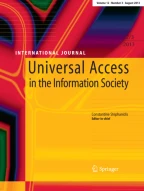Abstract
Human–computer interaction (HCI) research aims to make systems versatile, easy to use, and accessible for most people. The abundant information on the Internet and recent improvements in HCI technologies have improved how we acquire, share, and test our knowledge. While computer technologies have successfully remodeled and improved the learning process, the potential promised by these technologies has not become a reality for students with vision impairments. This paper presents MyAccessible Math, an open-source web platform designed with integrating user-centered design principles for SVIs to practice mathematics. Furthermore, we evaluate the voice and keyboard interaction on MyAccessible Math using experimental research designs. Experimental research designs investigated the effectiveness of the application with ten visually impaired elementary, middle, and high school students from the Alabama Institute for the Deaf and Blind and the Alabama School for the Blind. The experimental data show that voice and keyboard interaction helped students practice math questions.
Similar content being viewed by others
References
Secondary school programs and performance of students with disabilities: a special topic report of findings from the national longitudinal transition study-2 (NLTS2), 2013. https://ies.ed.gov/ncser/pubs/20123000. Last accessed 16 May 2022
Key employment statistics for people who are blind or visually impaired. https://www.afb.org/research-and-initiatives/statistics/key-employment-statistics. Last accessed 16 May 2022
Ahmed, I., Chao, T.: Assistive learning technologies for students with visual impairments: a critical rehumanizing review. Investig. Math. Learn. 10(3), 173–185 (2018)
Ahmetovic, D., Cantù, N., Bernareggi, C., Guerreiro, J., Mascetti, S., Capietto, A.: Multimodal exploration of mathematical function graphs with audiofunctions.web. In Proceedings of the 16th International Web for All Conference (pp. 1–2) (2019)
Asebriy, Z., Raghay, S., Bencharef, O.: An assistive technology for braille users to support mathematical learning: a semantic retrieval system. Symmetry 10(11), 547 (2018)
Ashraf, M.M., Hasan, N., Lewis, L., Hasan, M.R., Ray, P.: A systematic literature review of the application of information communication technology for visually impaired people. Int. J. Disabil. Manag. 11, 1 (2016)
Beal, C.R., Rosenblum, L.P.: Evaluation of the effectiveness of a tablet computer application (app) in helping students with visual impairments solve mathematics problems. J. Vis. Impair. Blind. 112(1), 5–19 (2018)
Dumkasem, K., Srisingchai, P., Rattanatamrong, P.: Eyemath: Increasing accessibility of mathematics to visually impaired readers. In 2019 23rd International Computer Science and Engineering Conference (ICSEC) (pp. 197–202). IEEE (2019)
Elkabani, I., Zantout, R.: A framework for helping the visually impaired learn and practice math. In 2015 5th International Conference on Information & Communication Technology and Accessibility (ICTA) (pp. 1–5). IEEE (2015)
Filloy, E., Rojano, T.: Solving equations: the transition from arithmetic to algebra. Learn. Math. 9(2), 19–25 (1989)
Grossman, J., Lin, Z., Sheng, H., Wei, J. T.-Z., Williams, J. J., Goel, S.: Mathbot: Transforming online resources for learning math into conversational interactions. AAAI 2019 Story-Enabled Intelligence (2019)
Gulliksen, J., Göransson, B., Boivie, I., Blomkvist, S., Persson, J., Cajander, Å.: Key principles for user-centred systems design. Behav. Inf. Technol. 22(6), 397–409 (2003)
Jackson, R.M.: Audio-Supported Reading for Students who are Blind or Visually Impaired. National Center on Accessible Instructional Materials, Wakefield (2012)
Jariwala, A.: MyAccessible Math: Shining Light on Math Concepts for Visually Impaired Students. PhD thesis, Auburn University (2022)
Jariwala, A., Marghitu, D., Chapman, R.: Mathematics learning technologies for students with visual impairments: a literature review
Jariwala, A., Marghitu, D., Chapman, R.: Mya+math: teaching math to students with vision impairment. In International Conference on Human–Computer Interaction (pp. 200–211). Springer, 2020
Jariwala, A., Marghitu, D., Chapman, R.: A Multimodal Platform to Teach Mathematics to Students with Vision-Impairment, pp. 109–117. Springer International Publishing, Cham (2021)
Klingenberg, O.G., Holkesvik, A.H., Augestad, L.B.: Digital learning in mathematics for students with severe visual impairment: a systematic review. Br. J. Vis. Impair. 38(1), 38–57 (2020)
Li, Q., Ma, X.: A meta-analysis of the effects of computer technology on school students’ mathematics learning. Educ. Psychol. Rev. 22(3), 215–243 (2010)
Maćkowski, M., Brzoza, P., Żabka, M., Spinczyk, D.: Multimedia platform for mathematics’ interactive learning accessible to blind people. Multimed. Tools Appl. 77(5), 6191–6208 (2018)
Norman, D.: The Design of Everyday Things: Revised and Expanded Edition. Basic Books, New York (2013)
Ohshiro, K., Hurst, A., DuBois, L.: Making math graphs more accessible in remote learning: Using sonification to introduce discontinuity in calculus. In The 23rd International ACM SIGACCESS Conference on Computers and Accessibility (pp. 1–4) (2021)
Otten, M., Van den Heuvel-Panhuizen, M., Veldhuis, M.: The balance model for teaching linear equations: a systematic literature review. Int. J. STEM Educ. 6(1), 1–21 (2019)
Sheikh, W., Schleppenbach, D., Leas, D.: Mathspeak: a non-ambiguous language for audio rendering of mathml. Int. J. Learn. Technol. 13(1), 3–25 (2018)
Acknowledgements
We thank the students and educators at AIDB and ASB for their support in this study.
Author information
Authors and Affiliations
Corresponding author
Ethics declarations
Conflict of interest
The prototype of the application and further improvements were described in [14,15,16,17] by the authors. The application and its evaluation are the result of the work conducted during the doctoral study [14] of Jariwala, Abhishek. The authors declare that they have no conflict of interest.
Additional information
Publisher's Note
Springer Nature remains neutral with regard to jurisdictional claims in published maps and institutional affiliations.
Rights and permissions
Springer Nature or its licensor (e.g. a society or other partner) holds exclusive rights to this article under a publishing agreement with the author(s) or other rightsholder(s); author self-archiving of the accepted manuscript version of this article is solely governed by the terms of such publishing agreement and applicable law.
About this article
Cite this article
Jariwala, A., Jamshidi, F., Marghitu, D. et al. Development and assessment of MyAccessible Math: promoting self-learning for students with vision impairment. Univ Access Inf Soc (2023). https://doi.org/10.1007/s10209-023-01068-w
Accepted:
Published:
DOI: https://doi.org/10.1007/s10209-023-01068-w
